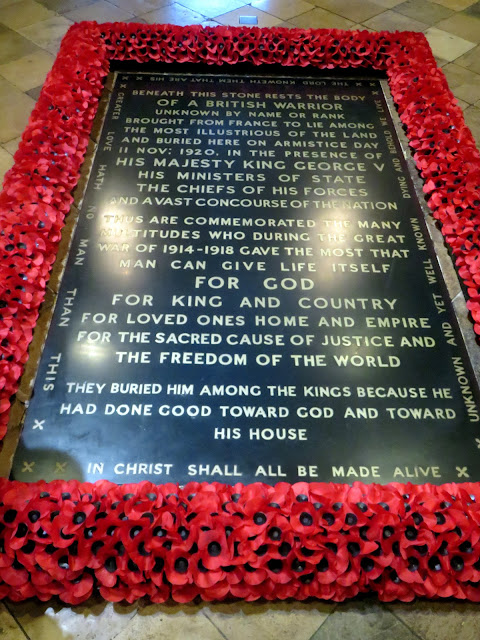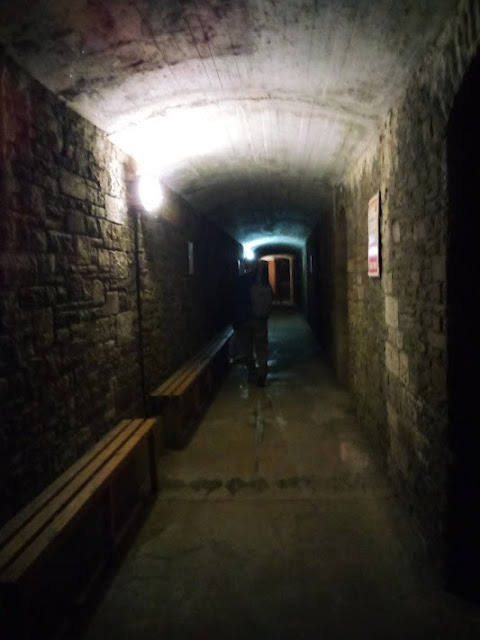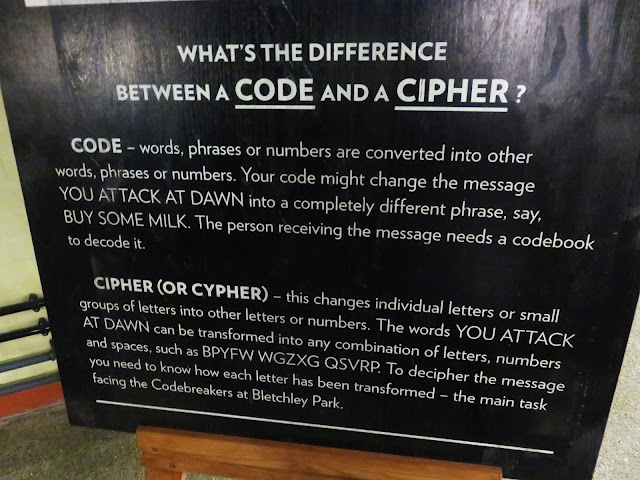Those of us in America may well have had parents or grandparents who served overseas in World War I or World War II, and many did not return home. But our country was not physically attacked. We may have had blackouts or rations, our men and women and working to support the war effort. But we were not bombed, with entire cities and towns being destroyed. Many in my own generation may or may not have served in the military. In Europe, it was a different story.
On November 11, 1918, World War I ended. One year later in the U.S., president Woodrow Wilson introduced Armistice Day, which honored the end of that way. In the UK, Remembrance Day (or Poppy Day, because people wear red poppies that day) evolved from Armistice Day. It was during World War II that the name of the holiday was changed to Veterans Day in the U.S. Now we honor all veterans on this holiday. But many are remembered every day through memorials, and we saw many during our recent trip to England.
Harry Patch is buried in the churchyard cemetery near Monkton Combe. He fought valiantly in World War I and was at the Battle of Passchendaele. After the war he became a peace activist. I wrote about this remarkable man in detail HERE. His grave is continually marked with a poppy wreath.
In Wells Cathedral, the Chapel of St. Martin honors the veterans. A collection of poppy wreaths is displayed.
And in London, there are many memorials. A Cenotaph is a monument honoring a person or a group of people who are buried elsewhere and whose remains are lost. The London Cenotaph was designed by Sir Edwin Lutyens and honors those who died in WWI and other conflicts. It is the site of the annual National Service of Remembrance.
Just past the Cenotaph on Whitehall, located at the end of Downing Street, is the monument to the Women of World War II. The sculpture represents the wartime contributions of more than seven million women, including 650,000 who joined military services.
Very near St. Paul's Cathedral, another monument honors those whose service was fighting the fires made by the bombs dropped on the city during the Blitz.
And in Westminster Abbey, the tomb of the unknown remains framed by poppies.
Of course, veterans are technically considered those in military service. But there are many ways in which civilians aided the war effort. For those of wealth and property with great homes, it was a matter of sharing those spaces to help the warm effort. That includes such spots we visited as Cardiff Castle, Basildon Park and Hughendon, the home of Benjamin Disraeli.For me, the most memorable part of Cardiff Castle was the underground tunnel that served as a shelter during World War II.
As we walk past the canteen, we notice benches against walls and posters with wartime slogans of the day.
But most powerful is the audio that accompanies this walk. As you walk through, bombs are exploding, there is a sound of panic, addresses by Chamberlain saying that Britain is at war and another by Churchill, along with "We'll Meet Again" sung by Vera Lynn. You can imagine scores of people down here, waiting out the bombing.
Basildon Park is a historic home that was used during the wars as both hospital and POW camp for Italian prisoners. During WWI, the home became a convalescent home for officers and soldiers. Disabled soldiers and sailors could participate in a training center to learn new skills.
In the first World War, the estate was run by the Women's Land Army,who cared for livestock and maintained the estate, even making as much as 3,000 bricks weekly. This is the uniform of the lady of the manor who oversaw the estate during World War II.In World War II Basildon Park was requisitioned first as a training site for the American Army and then as a POW camp.
The POWs worked on local farms and in a tea room in the village. They were said to be very friendly and after the war, a number of them settled in the area, having made friendships with the people with whom they had worked.
At Hughenden, the Air Ministry requisitioned the home and it became a map-making base, an operation so secret that it took sixty years to be revealed, discovered when a visitor who had been part of this effort revealed it to a volunteer.
More than 100 men and women produced RAF maps during four years of the war.
And then, there was Bletchley Park, where the enigma code was broken. But that's for another post.
Right now there are wars going on throughout the world. May we all wish for that elusive thing called peace and healing to those who have served so valiantly.























41 comments:
Growing up in the northeast, where bombing and near starvation were our experience as little children, every town and village had its war memorial. They were often a landmark, and as a little kid I assumed every town in the world had one.
...I've always enjoyed the bright red poppies!
I have just finished listening to a biography of General Sir John Monash - from what I learned, he would have agreed wholeheartedly with your Harry Patch.
Our main remembrance occasion is Anzac Day (April 25) but we always observe a minute's silence for Remembrance Day.
I love how you pulled together all these things. Having grown up at a time where everyone remembered WW2 I tend to take it for granted, while also being ever mindful of what happened and the sacrifices made by so many. On a side note, what beautiful writing Gefreiter Josef Gunter had.
Bravo! What a fine post!
Our neighbour at the back would sometimes blast the old songs, like Vera Lynn and We''ll Meet Again or White Cliffs of Dover. His wife apologized, but I liked hearing the music as we were out in the garden on a Saturday morning.
Your post also reminded me of The Bletchley Circle tv series. It was quite a good one. https://en.wikipedia.org/wiki/The_Bletchley_Circle
Thanks for sharing these remembrances. I recently read a historic fiction on the Land Girls and was fascinated by what all they did. This era fascinates me, possibly because I was born during WWII. May we never forget.
I think of that often; how lucky, fortunate, and how we take for granted that we have never had a war in modern America. When a jet flies over, we look up and do not worry. Other places, that is not the case.
Having grown up during the years immediately after the end of WWII, its history was our history: often in some odd ways. The paternal side of my family never talked about the son whose portrait hung on the wall of every home. Only after the arrival of the internet did I finally find one of my uncles, buried in Manila. These memorials are so important; as the generations who experienced this war fade away, the memorials will still stand.
That series was very good!
One of my clients during my career was a veteran at the age of 15 living in England he enlisted .He is about 95..He was awarded the highest honor for his contribution in the liberation of Normandy.I enjoyed working for this gentleman .
Oops 99 he was born in 25
Thank you for sharing.
www.rsrue.blogspot.com
i really enjoyed reading this post...a bit of history i know, but a great reminder of what i needed to be reminded of. i have 2 sons that were not drawn to military service, i am reminded of the draft and that they never had to worry about that!! this was a great time to share this information and i enjoyed the images as well. veterans day, may we honor all of them!!
This is a wonderful article Jeanie, one I enjoyed very much. i grew up with my mother telling me about her times in the WWII bomb shelters. Everyone sang old songs and there was someone who told a joke or two to keep spirits up. This when the bombs were falling around them. Thanks for sharing your experiences over there.
One of the things that surprised me about visiting France was seeing all the tributes to soldiers who helped oust the bad guys during the world wars.
Thanks so much for this interesting and informative post! It was a painful time of history and, as your post illuminates, no Briton was left unscathed. I wonder how it affects people to have so much of this history still visible in their daily lives.
What a great post. Other than having seen the Cenotaph and knowing about poppies, most of the rest of this is new to me. Funny how our Veteran's Day has a bit of a different take than in Britain. I love the design of the women of WW2 monument. Of course Europes history in the 20th century was much more war torn. Have you ever visited the War Museum (not sure that is the right name) in London? Not Churchill's war rooms, but the actual museum about various conflicts? They have (or had) a wonderful WW1 trench exhibit where they ever recreated the smell. I can still picture it and smell it when I think about it. Hope you had a great weekend. hugs-Erika
Lest we forget
I am very impressed with your post. It is brilliant how you connected and brought everything together. I would love to see this post on FFO. The women's memorial is very touching. Again I am very impressed with this post and I thank you for it.
Jeanie, this post is so interesting and well written! Thanks so much for sharing!
Yes, let there be peace on earth, and let it begin with me.
Wonderful post. I've never made it to Europe. I've wanted to go to England since I was a child. Somehow life always got in the way.
That visit in the tunnels must´ve been very scary. Australians have poppies as this symbol also.
I still have a sachet of poppy seeds with a soldier on it .saying "LEGACY" from ANZAC day 2015.
And you know what Germans did in the South today at 11:11? They opened their carnival-festivals. Disrespectful in my eyes.
Thank you so much for the history! How people pulled together to support each other is simply amazing! I am so glad you are telling the stories.
Hooray for Harry Patch. I remember well when you wrote about him earlier, Jeanie. For some reason this post did not come through on my reading list and had I not noticed it on an other blog I would have missed it altogether. We'll see what happens next time you post.
My husband served in Korea ..My grandfather in WWII..I have some of my grandfathers letters to my grandmother from those days...Our family has more than its share of Veterans..
Intersting post Jeannie..
What a great post. I had work off at my cleaning business today for the holiday so I have been trying to do some reading to commemorate. Thank you for sharing this.
This was the perfect post on such a special day, jeanie, and thanks for all the historical background. Nashua, NH, had a veterans day parade which I attended.
Fabulous post! When I was in England in 2023 I went with my English friends to the American cemetery in Cambridge. I'd already seen one of the Commonwealth cemeteries in France and both visits were so moving. It was an honor to be able to visit with those who made the ultimate sacrifice.
A beautiful tribute. I always get weepy during the services on November 11 @ the 11th hour thinking about what these brave souls went through for us. May we never forget and may the young people never forget. I'm pleased to see that locally there are various initiatives to involve the school age children in various ways in the many memorial services we have throughout the country.
A wonderful post Jeanie.
Thank you.
All the best Jan
This is a beautiful tribute.
A sobering reminder of war. That would have been chilling to walk through that tunnel and imagine people huddling there for safety.
Thank you for sharing all this important history Jeanie, you saw so much on your trip, thanks for taking us along~
Jenna
Thank you for re posting this for me and sharing it with FFO. It is such a fantastic bit of history. Have a wonderful weekend.
Such an interesting post. I remember the firefighters and Women of World War II monuments. When we were in Normandy during our recent trip we visited the D Day beaches as well as Dunkirk - very interesting and moving.
Thank you for your comment on my blog - I wasn't able to reply since it was a no-reply comment. Have you changed something?
What an interesting article. My Dad served in England, met my mother there. When I visited England I was struck by the many memorials, a couple with the names of my great-uncles who died in WWI. And on the tours, bomb sites and the Second World War were very much talked about. We saw poppy wreaths everywhere. The war is still very much alive in the country's mind.
Thank you for sharing Harry Patch's grave. He was a dear friend of my Nan and I have a collection of letters and articles he sent her over the years.
Wow that underground tunnel with the sounds of bombings and such would have had such an impact and really gives you a bit of a sense of what the people of England and other war-torn areas went through and continue to go through. War is just so very terrible. May peace prevail someday.
This Remembrance Day was different for me. This year I've commemorated the British soldiers who lost their lives fighting in Ukraine. I told one of their sister that I will think of her brother on Remembrance Day and I did that.
After being in Ukraine for 3 times and using a shelter, knowing that missiles and drones are heading towards the city I was in... I think of these places differently, less gloomy. People can laugh in the face of danger and that is missing from these memorials. It's one of those things, a "you had to be there" situation.
I always love how you can take all your photos and then find a theme like this to pull it together. Thank you! I read The Last Bookstore in London last spring. I was getting burned out on recommended WWII novels, but this one was different and immersed one in the Blitz as civilians. It was a good book. a tough read, but I learned much about their experience in London I never really thought about. Inspired by some true stories of bookshop survival….
Post a Comment